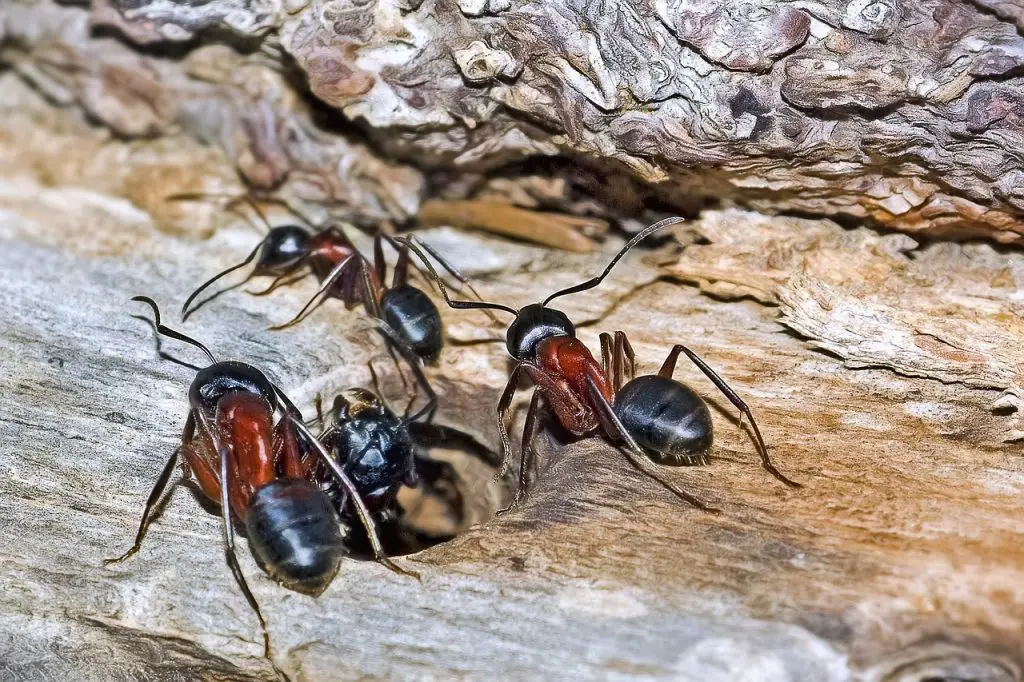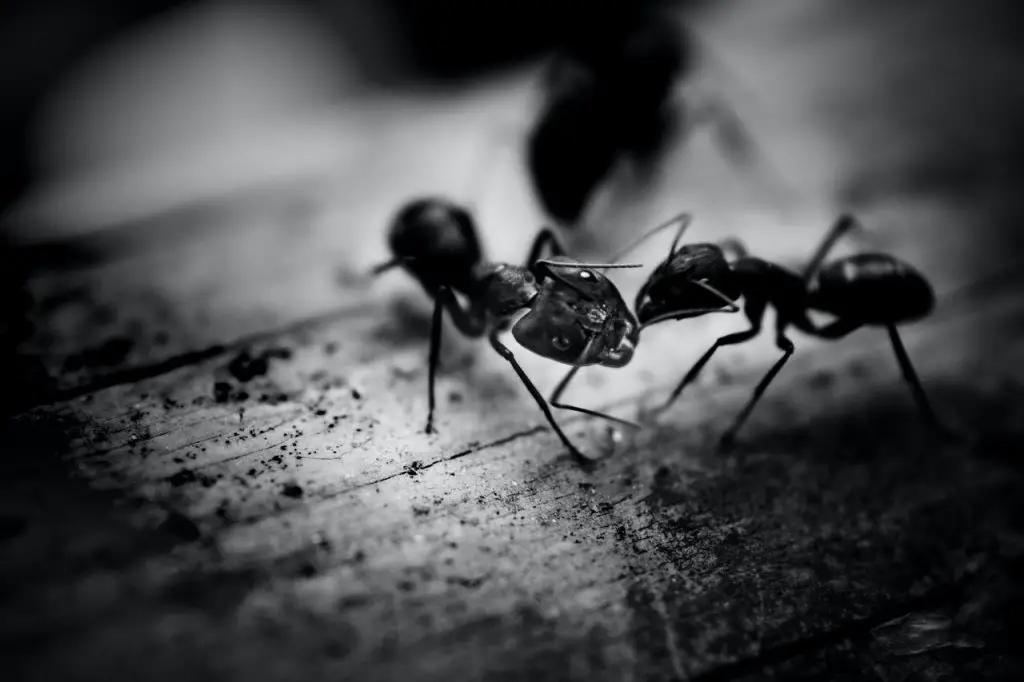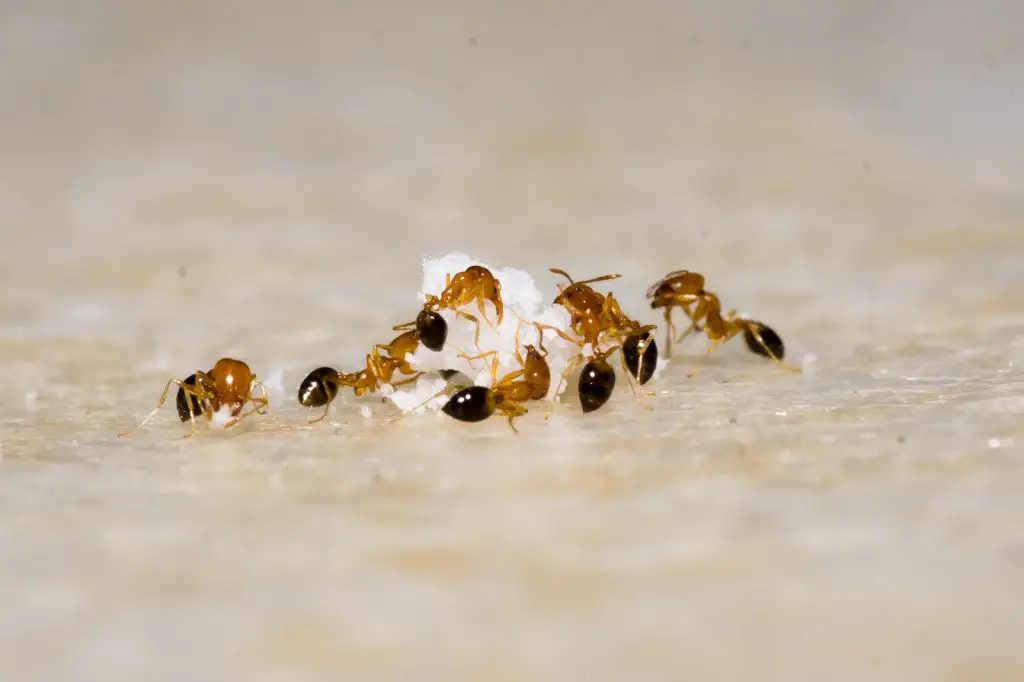Are you tired of battling ant infestations in your home?
Meet the two most common contenders, the mighty carpenter ant and the ubiquitous black ant. While they may look similar at first glance, these two types of ants have vastly different behaviors and characteristics that make them stand out from one another.
Get ready to learn about their differences, and habits, and how to keep them out of your space for good!
Identification and Physical Characteristics of a Carpenter and Black Ant
At first glance, carpenter ants and black ants may look similar in appearance. After all, they’re both six-legged insects with segmented bodies and antennae. But don’t let their superficial similarities fool you, these two types of ants are actually quite different in a number of ways.
Differences in behavior
Carpenter ants
- They are known to damage wood structures and are often considered a pest.
- Carpenter ants typically nest in damp and decaying wood.
- They do not eat the wood but excavate it to create tunnels for their nests.
Black ants
- They are generally not considered a pest, but some species may invade households in search of food.
- Black ants typically nest underground or in soil, but may also build nests in dead wood or in walls.
- They are known to forage long distances from their nests in search of food.
Differences in diet
Carpenter ants
- They are omnivores and feed on both plant and animal matter.
- Carpenter ants prefer sweet foods, but will also eat proteins such as dead insects.
Black ants
- They are also omnivores and feed on a variety of foods including insects, nectar, honeydew, and other sweet substances.
- Some species of black ants have specialized diets and will only feed on certain types of foods.
Differences in colonies
Carpenter ants
- Carpenter ant colonies can be quite large, with up to 10,000 workers and multiple queens.
- They are usually located in damp or decaying wood and can cause structural damage to buildings.
Black ants
- Black ant colonies are typically smaller than carpenter ant colonies, with up to a few hundred workers and a single queen.
- They usually nest underground or in soil, but may also build nests in walls or other small cavities.
Differences in physical features
Carpenter ants
- Carpenter ants have large mandibles, which they use for excavating wood and for defense.
- They have a smooth and curved profile on their thorax.
- carpenter ants tend to be larger than black ants, size of a carpenter ant is between 6 to 13 millimeters in length.
Black ants
- Black ants have smaller mandibles compared to carpenter ants.
- They have a more angular and flattened profile on their thorax.
- black ants are generally smaller than carpenter ants size of black ants is between 2 to 4 millimeters in length
Habits of Carpenter Ant vs Black Ant

Nesting habits of carpenter ants and black ants
- Carpenter ants prefer to nest in moist and decaying wood, such as tree stumps or wooden structures in homes.
- Black ants often build their nests in soil, but can also nest in cracks and crevices in buildings or under rocks.
Differences in diet and foraging behaviors
- Carpenter ants are primarily protein feeders and will feed on other insects, living or dead.
- Black ants have a diverse diet that includes insects, seeds, fruits, and sugary substances like honeydew.
- Carpenter ants will create foraging trails to food sources, while black ants will often scavenge individually.
Communication Methods and social structures
- Carpenter ants communicate with each other using chemical signals called pheromones, which they leave behind as they travel.
- Black ants also use pheromones to communicate, but they also use tactile communication through touch.
- Carpenter ants have a hierarchical social structure, with a queen and workers, while black ants have a more flexible social structure without a distinct queen.
Damage Caused by Carpenter Ants and Black Ants
Both carpenter ants and black ants can cause damage, but the type of damage they inflict is different and the carpenter ant causes more damage and make things worse.
Prepare to be amazed by the differences between these two ant species. Here’s what you need to know!
Carpenter ants are known for their destructive behavior, as they like to make their nests in wood.
They excavate galleries in the wood, which can weaken the structural integrity of buildings and homes. If left unchecked, carpenter ants can cause significant damage that can be expensive to repair.
For carpenter ants, it’s crucial to identify the nest and take action to remove it. This may involve using insecticides or physically removing the nest to prevent further damage.
Did you know that during the construction of a castle in 14th century Scotland, builders observed carpenter ants carrying grains of sand up the walls and used them to create a more durable mortar by mixing them with lime? While this practice is not recommended today.
Carpenter ants bites can be painful, but they are not typically dangerous unless a person has an allergic reaction. A bite may result in swelling, redness, and discomfort around the affected area. Some people may also experience itching or a burning sensation.
Black ants are generally less destructive than carpenter ants. While they can still be a nuisance and invade homes in search of food.
Their damage is usually limited to unsightly trails as they move back and forth between their nest and food sources.
Black ant bites are generally not harmful to humans, but they can cause some discomfort. The bite may cause a small, red bump that can be itchy or painful. In some cases, multiple bites can lead to an allergic reaction, which can be serious.
Identify Carpenter Ants in the House
Carpenter ants leave behind several signs in a house, including wood shavings, rustling noises inside walls or woodwork, small holes in wood, and winged ants around windows and doors.
Carpenter ants are larger than most other ant species, typically measuring between 1/4 and 1/2 inches long. They are usually black, but some species may have a reddish or yellowish color.
You can also look for their nests, which are typically located in moist or decaying wood, such as around windowsills, doorframes, or other areas with water damage. Carpenter ants create smooth tunnels and galleries inside the wood, which can weaken the structure of your home.
They also prefer moist wood and may be found near plumbing fixtures or leaky roofs. If you suspect an infestation, it’s important to address it promptly as carpenter ants can cause significant damage to a home’s structure over time.
Find Black Ants in House
To identify black ants, you can observe their color, size, behavior, and where they build their nests. Black ants are typically small to medium-sized, around 1/16 to 1/2 inch long, and they are often found in large colonies.
You may see them marching in lines or swarming around food sources. Their nests are typically located in dark, moist areas such as behind baseboards, in wall voids, or under sinks.
Observe the ant’s behavior black ants are typically found in large colonies and can be seen marching in lines or swarming around food sources.
How to Prevent Damage From Carpenter Ants and Black Ants
- Keep your home clean and free of food debris: This will reduce the chance of attracting ants into your home.
- Seal any cracks or openings in your home’s exterior: This will prevent ants from entering your home in search of food and moisture.
- Remove any decaying or moist wood around your home: This will eliminate potential nesting sites for carpenter ants.
- Trim trees and shrubs to prevent contact with your home: This will prevent ants from using branches as a bridge to enter your home.
- Keep firewood and other woodpiles away from your home: This will reduce the chance of attracting carpenter ants to your property.
- Repair any leaky pipes or faucets to eliminate moisture: Ants are attracted to moist environments, so fixing leaks can make your home less appealing to them.
- Use ant baits or natural remedies: To keep ants away from your home this is a safe and effective way to keep ants at bay without using harmful chemicals.
Conclusion

Carpenter ants are known for damaging wood structures, while black ants are generally not considered a pest but may invade households in search of food.
Carpenter ants prefer sweet foods and have large mandibles, while black ants have a more flexible social structure and a diverse diet.
To prevent damage, keep your home clean and seal any cracks or openings in your home’s exterior.



